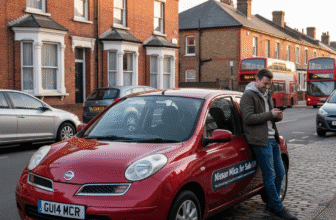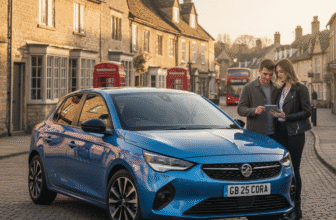
The Ultimate 2025 Guide to Buying a Car in the UK: Navigating the New, Used, and Electric Maze
There are few purchases in life as exciting, or as daunting, as buying a car. It’s more than just a metal box on wheels; it’s a ticket to freedom, a daily workhorse, a family memory-maker, and often, a significant financial commitment. The UK car market in 2025 is a more complex and fascinating landscape than ever before. We’re standing at a crossroads of technology, with traditional petrol and diesel engines vying for attention against a rising tide of hybrid and fully electric vehicles. Add to that the fluctuating costs, a vibrant used car scene, and a myriad of financing options, and it’s easy to feel overwhelmed.
Fear not. This comprehensive guide is your roadmap to navigating the entire process, from the first spark of an idea to the satisfying moment you drive away in your perfect vehicle. We’ll demystify the jargon, break down the choices, and empower you to make a confident, informed decision that’s right for your lifestyle and your wallet.
Chapter 1: The First Big Question – New or Used?
Before you even think about makes and models, you need to decide which forecourt you’re heading to: the gleaming showroom of new cars or the diverse world of pre-owned vehicles. Each path has distinct advantages and disadvantages.

The Allure of the Brand New Car
The appeal of a new car is undeniable. That intoxicating ‘new car smell’ is just the start. You get a pristine vehicle with zero miles on the clock, untouched by any previous owners. You are the first and only person to drive it.
- Peace of Mind: A new car comes with a comprehensive manufacturer’s warranty, typically lasting anywhere from three to seven years. This covers most mechanical and electrical faults, giving you worry-free motoring for a significant period.
- Latest and Greatest: You benefit from the very latest advancements in safety technology, fuel efficiency, and in-car entertainment. Features like advanced driver-assistance systems (ADAS), large touchscreens with smartphone integration, and more efficient engines are standard fare.
- Customisation: Buying new means you can specify your car exactly as you want it. From the paint colour and alloy wheels to the interior trim and optional extras, you get to build your dream machine from the ground up (though this can often lead to a factory order and a waiting period).
- Attractive Finance: Manufacturers often offer highly competitive finance deals, such as 0% APR or deposit contributions, exclusively on new models to entice buyers.
However, the biggest drawback is depreciation. The moment you drive a new car off the forecourt, it starts losing value. It’s not uncommon for a car to lose 20-30% of its value in the first year alone. The initial purchase price is also, of course, the highest it will ever be.
The Savvy Choice of a Used Car
For many, the smart money is on a used car. By letting the first owner absorb the initial, steep depreciation, you can get a lot more car for your money.
- Value for Money: The primary benefit is cost. A three-year-old car, for example, might have lost up to 50% of its original value but may still have many years of reliable service left in it. Your budget can stretch to a higher-spec model or a more premium brand than if you were buying new.
- Less Depreciation: While used cars still depreciate, the rate is far slower than with a new vehicle. The biggest financial hit has already been taken.
- Wider Choice: The used market is vast. You have decades of makes and models to choose from, not just what’s currently in production.
The trade-off is the element of risk. A used car has a history, and it might not always be a good one. There’s no manufacturer warranty (unless it’s a nearly-new car still within its original period), and you’re responsible for any faults that may arise. This is why thorough research and pre-purchase checks are absolutely non-negotiable when buying used.
The Sweet Spot: ‘Nearly New’ and ‘Approved Used’
A brilliant compromise exists in the form of ‘nearly new’ or ‘approved used’ cars. These are often ex-demonstrator models, pre-registered vehicles (cars a dealership registers to meet sales targets), or cars that are only 6-18 months old. You get a vehicle that is practically new, with low mileage and the balance of its manufacturer warranty, but without the full new-car price tag. Main dealers run ‘Approved Used’ schemes that include rigorous multi-point checks and their own limited warranty, offering fantastic peace of mind.
Chapter 2: Fuelling Your Future – Petrol, Diesel, Hybrid or Electric?
The choice of what powers your car is more critical than ever, with long-term financial and environmental implications. The UK is on a path to phase out new petrol and diesel car sales by 2035, so your decision has real weight.
Petrol and Diesel: The Familiar Faces
For decades, this was a simple choice. Modern petrol engines are efficient, quiet, and great for those who do a mix of driving, especially around town. Diesel engines, with their superior torque and fuel economy, have traditionally been the choice for high-mileage drivers who spend a lot of time on the motorway. However, the landscape for diesel is changing. Increased taxation and the expansion of Clean Air Zones (CAZ) and London’s Ultra Low Emission Zone (ULEZ) mean that owning an older diesel car, in particular, can be costly if you need to drive into city centres.
Hybrids: The Best of Both Worlds?
Hybrids offer a stepping stone between traditional combustion engines and full electrification. They combine a petrol engine with an electric motor to improve efficiency.
- Mild Hybrid (MHEV): The simplest form. A small electric motor assists the engine to reduce load and save a little fuel, but it can’t power the car on its own.
- Full Hybrid (HEV): Also known as a ‘self-charging’ hybrid. These can run on pure electric power for very short distances at low speeds, such as in stop-start traffic. The battery is charged by the engine and through regenerative braking. They offer significant fuel savings in urban driving.
- Plug-in Hybrid (PHEV): These have a much larger battery that you can charge from an external power source. This gives them a significant electric-only range, often 30-50 miles. For drivers with a short commute, you could potentially do most of your daily driving on cheap electricity, using the petrol engine only for longer journeys.
The Electric Revolution: Battery Electric Vehicles (BEVs)
Fully electric cars have zero tailpipe emissions and are the future of personal transport. The pros are compelling: running costs are incredibly low (charging at home is far cheaper than buying petrol), performance is often startlingly quick and silent, and maintenance is simpler with fewer moving parts. However, you must consider the cons. The initial purchase price is still higher than a comparable petrol car, though this gap is closing. ‘Range anxiety’ is a common concern, but with modern EVs regularly achieving real-world ranges of 200-300 miles, it’s becoming less of an issue for most. The biggest factor is charging; if you can’t charge at home on a driveway or dedicated spot, relying solely on the public charging network can be inconvenient and more expensive.
Chapter 3: Budgeting and Finance – The Nitty-Gritty
Before you fall in love with a car, you need to be honest about what you can afford. Your budget should encompass more than just the windscreen price. You must calculate the Total Cost of Ownership (TCO).
Factor in these costs:
- Insurance: This can vary wildly depending on the car, your age, and your postcode. Get quotes before you buy.
- Vehicle Excise Duty (VED or ‘road tax’): For cars registered after April 2017, most people pay a flat annual rate, but there’s a hefty surcharge for cars with a list price over £40,000. Electric cars are currently exempt, but this is set to change.
- Fuel/Charging: Calculate your likely monthly spend based on your average mileage.
- Servicing and Maintenance: New cars often have service plans, but for used cars, you’ll need to budget for annual servicing, MOTs (for cars over three years old), and consumable parts like tyres and brakes.
How to Pay for It
- Cash: The simplest option. You own the car outright from day one.
- Personal Loan: Borrowing a fixed sum from a bank or lender. You also own the car immediately and can sell it whenever you want. Rates can be very competitive.
- Hire Purchase (HP): You pay a deposit followed by fixed monthly payments. Once the final payment is made, the car is yours. It’s a straightforward way to own a car over time.
- Personal Contract Purchase (PCP): This is the most popular way to finance a new car in the UK. You pay a deposit and low monthly payments that cover the car’s depreciation, not its full value. At the end of the term (e.g., 3 years), you have three choices:
- Pay a large final ‘balloon’ payment to own the car outright.
- Hand the car back and walk away (subject to mileage and condition clauses).
- Use any equity (if the car is worth more than the balloon payment) as a deposit on a new PCP deal.
Chapter 4: The Hunt – Where to Look and What to Check
Once you have your budget and a shortlist of models, the real fun begins. You can buy a used car from several places:
- Franchised Dealers: Offer the highest level of security through ‘Approved Used’ schemes but are often the most expensive.
- Independent Dealers: A huge variety of stock and price points. Check their reviews and reputation carefully.
- Car Supermarkets: Large, no-haggle sites with thousands of cars. Efficient but can be impersonal.
- Private Sellers: The cheapest route but also the riskiest. It’s ‘buyer beware’ with no comeback if things go wrong.
The Essential Pre-Purchase Checks
For any used car, these steps are vital. Do not skip them.
- Vehicle History Check: Use a service like HPI or Experian. For a small fee, it will tell you if the car has outstanding finance, has been stolen, or has been written off by an insurer. This is the single most important check you can make.
- Check the MOT History Online: The UK Government’s free online service lets you see a car’s entire MOT history, including passes, fails, and advisory notes. It’s a fantastic window into the car’s past health.
- The V5C Logbook: Check that the seller’s name and address match the details on the V5C document. Make sure the VIN (Vehicle Identification Number) on the document matches the one on the car (usually at the base of the windscreen and on a plaque in the door jamb).
Chapter 5: The Test Drive and Inspection
A car can look perfect on paper, but the test drive is where you find out if it’s right for you. Try to drive on a variety of roads – a bit of town traffic, a faster A-road, and a dual carriageway if possible – to see how it performs in different situations. During the drive, turn the radio off and listen. Are there any strange knocks, rattles, or whines? Does the steering pull to one side? Are the brakes strong and responsive? Does the clutch and gearbox feel smooth?
Before the drive, give the car a thorough visual inspection. Look for mismatched paint which could indicate a previous repair, check the tyre tread is legal and even, and test every single button and switch inside the cabin, from the electric windows to the air conditioning. It’s your money; be meticulous.
Chapter 6: Sealing the Deal
If you’re happy with the car, the checks, and the test drive, it’s time to negotiate. With private sellers and most dealers, the asking price is usually a starting point. Be polite but confident. Use any faults you found (e.g., tyres that will need replacing soon) as leverage. Having done your research on what similar cars are selling for will strengthen your position. Know your maximum price and be prepared to walk away if the seller won’t meet it.
Once you agree on a price, get everything in writing on a receipt or buyer’s invoice. This should state the car’s details, the price you paid, and both yours and the seller’s details. Never pay with a large amount of physical cash; a bank transfer is the most secure method. Complete the relevant section of the V5C logbook to transfer ownership, and don’t forget to tax and insure the vehicle before you drive it away – it’s a legal requirement.
Buying a car is a journey, and like any good road trip, preparation is key. By taking your time, doing your homework, and trusting your instincts, you can cut through the noise and confusion of the modern car market. The right car for you is out there waiting, and the open road awaits.







